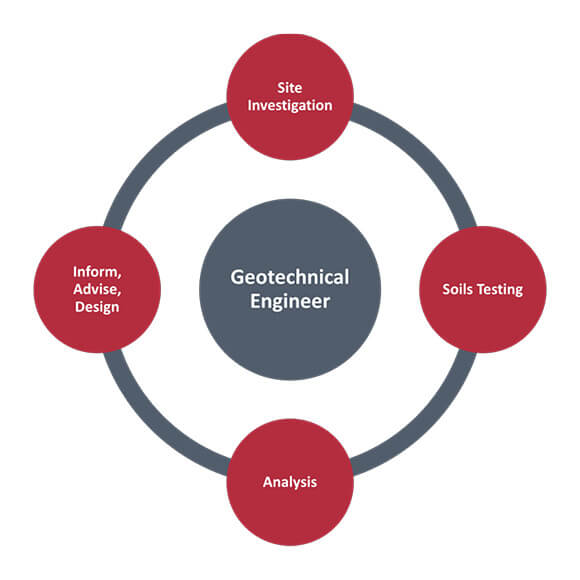Things about Geotheta
Things about Geotheta
Blog Article
The 4-Minute Rule for Geotheta
Table of ContentsLittle Known Questions About Geotheta.The 10-Minute Rule for Geotheta4 Easy Facts About Geotheta ShownThe Ultimate Guide To GeothetaHow Geotheta can Save You Time, Stress, and Money.

They carry out website investigations, gather examples, carry out laboratory examinations, and evaluate data to review the suitability of the ground for building and construction jobs - Geo Tech Engineering. Based upon their findings, geotechnical engineers supply referrals for structure layout, slope stability, retaining frameworks, and mitigation of geotechnical risks. They collaborate with various other specialists, such as architects, architectural designers, and building teams, to make certain that geotechnical factors to consider are integrated into the total project layout and application
By analyzing the actions and residential properties of soil and rock, they can identify possible geotechnical threats such as landslides, dirt settlement, or slope instability. Their competence helps avoid failings or mishaps that might jeopardize lives and building. Right here are some in-depth responsibilities and responsibilities of a geotechnical engineer: Website Examination: Geotechnical engineers conduct website investigations to gather information on subsurface conditions.
They translate the information to comprehend the properties and actions of the dirt and rock, including their toughness, permeability, compaction qualities, and groundwater problems. Geotechnical Evaluation and Design: Geotechnical designers analyze the data accumulated during website investigations to evaluate the security and suitability of the site for building and construction jobs. They do geotechnical computations and modeling to examine factors such as bearing capacity, negotiation, incline security, lateral planet stress, and groundwater circulation.
An Unbiased View of Geotheta
Structure Design: Geotechnical designers play an important role in designing foundations that can securely support the intended structure. They evaluate the dirt problems and load needs to figure out the suitable foundation kind, such as shallow structures (e.g., footings), deep structures (e.g (https://profile.hatena.ne.jp/geotheta/)., piles), or specialized techniques like soil improvement. They consider factors such as settlement restrictions, birthing capacity, and soil-structure communication to develop optimal structure styles
They evaluate construction strategies, display website activities, and perform field evaluations to verify that the style suggestions are followed. If unpredicted geotechnical concerns emerge, they assess the situation and give recommendations for remediation or modifications to the design. Risk Analysis and Mitigation: Geotechnical engineers analyze geotechnical risks and risks connected with the job website, such as landslides, liquefaction, or soil disintegration.

Cooperation and Communication: Geotechnical designers work closely with other specialists included in a project, such as designers, structural designers, and construction groups. Effective interaction and collaboration are necessary to incorporate geotechnical considerations into the total task design and building and construction process. Geotechnical engineers provide technical expertise, response inquiries, and make certain that geotechnical demands are fulfilled.
The 2-Minute Rule for Geotheta
Below are some kinds of geotechnical designers: Structure Designer: Structure designers specialize in designing and assessing structures for frameworks. They evaluate the dirt conditions, tons requirements, and site features to determine the most suitable foundation type and design, such as shallow foundations, deep foundations, or specialized strategies like stack foundations.
They examine the aspects influencing slope security, such as dirt properties, groundwater problems, and incline geometry, and create techniques to stop slope failings and mitigate threats. Earthquake Designer: Earthquake engineers concentrate on assessing and creating structures to stand up to seismic pressures. They evaluate the seismic hazard of a website, assess dirt liquefaction possibility, and establish seismic design criteria to ensure the safety and strength of structures during earthquakes.
They do field screening, accumulate examples, and analyze the gathered information to identify the soil buildings, geologic developments, and groundwater conditions at a site. Geotechnical Instrumentation Engineer: Geotechnical instrumentation designers concentrate on surveillance and determining the behavior of dirt, rock, and structures. They mount and maintain instrumentation systems that check variables such as soil negotiation, groundwater levels, incline movements, and architectural displacements to analyze performance and give early cautions of potential problems.
The Definitive Guide to Geotheta
They more helpful hints conduct tests such as triaxial tests, combination examinations, straight shear examinations, and permeability examinations to collect information for geotechnical analysis and style. Geosynthetics Designer: Geosynthetics engineers concentrate on the style and application of geosynthetic materials, such as geotextiles, geogrids, and geomembranes. They make use of these materials to boost soil stability, reinforce inclines, give drain remedies, and control erosion.
They often tend to be investigative people, which means they're intellectual, reflective, and analytical. They are interested, systematic, sensible, analytical, and logical. A few of them are also social, implying they're kind, charitable, participating, person, caring, valuable, understanding, sensible, and pleasant. Does this audio like you? Take our free career test to figure out if geotechnical designer is among your leading occupation matches.
In the office atmosphere, geotechnical engineers make use of specialized software program devices to execute calculations, develop layouts, and assess data. They prepare reports, evaluation job requirements, communicate with clients and group participants, and coordinate job activities. The workplace setting offers a favorable setting for research, evaluation, and partnership with other specialists associated with the project.
Our Geotheta Diaries
They frequently check out project websites to conduct site examinations, assess geotechnical problems, and collect data for analysis. These visits include taking a trip to different areas, in some cases in remote or difficult surfaces. Geotechnical engineers might execute soil sampling, conduct examinations, and monitor building and construction tasks to ensure that the geotechnical facets of the project are being applied appropriately.
Geotechnical designers additionally work in specialized geotechnical labs. In these centers, they carry out experiments, execute tests on soil and rock examples, and evaluate the design homes of the materials. Geotechnical lab designers function thoroughly in these settings, handling screening devices, operating instruments, and taping information. They team up with various other research laboratory team to ensure precise and reliable testing outcomes.
Report this page